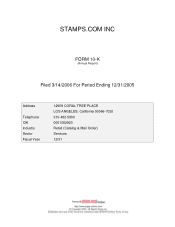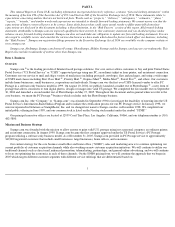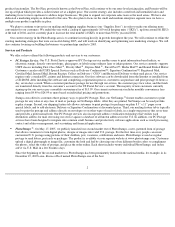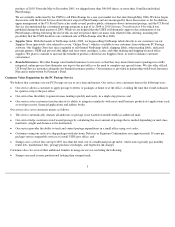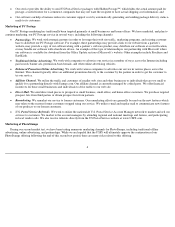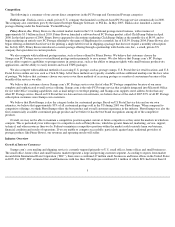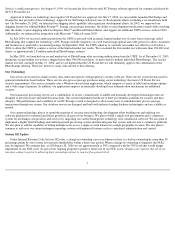Stamps.com 2005 Annual Report Download - page 9
Download and view the complete annual report
Please find page 9 of the 2005 Stamps.com annual report below. You can navigate through the pages in the report by either clicking on the pages listed below, or by using the keyword search tool below to find specific information within the annual report.
employees. In addition, income generating home offices numbered 14.7 million, and home offices used for corporate after-hours work or
telecommuting numbered 24.3 million. In addition to small office, home office and small business customers, consumers and corporations are
also currently customers of Stamps.com’s service.
US Mail Volume
According to the US Postal Service Annual Report, the total postage market was approximately $70 billion in 2005, of which
approximately $49 billion was represented by mail classes other than standard mail and periodicals. We believe that some portion of this $49
billion is a potential market for purchasing and printing postage using PC Postage.
The US Postal Service processed over 212 billion pieces of mail during its fiscal year 2005. A recent US Postal Service study estimated
that consumer-to-consumer mail volume is approximately 7.2 billion pieces per year, made up of the following segments: 2.6 billion
holiday/season greeting cards; 2.0 billion other greeting cards; 2.1 billion letters to friends or relatives; and 0.5 billion invitations. We also
estimate that an additional 10.5 billion pieces per year are sent between businesses and consumers, as business advertising mail. We believe
that consumer-to-consumer and business-to-consumer-advertising mail are two potential markets for use of PhotoStamps.
Traditional Postage Industry and the Emergence of PC Postage
The US Postal Service has experienced public demand for more convenient access to US Postal Service products and services, and has
faced strong competition from overnight delivery services and online transaction services. The US Postal Service also has historically
experienced lost revenue owing to fraud committed using traditional postal meters. In response to these challenges, in 1995 the US Postal
Service announced the Information Based Indicia (“IBI”) program, its first new form of postage since the approval of the postage meter in
1920. The information based indicia was a new type of US Postal Service postage mark that contained an information rich two dimensional bar
code. Each bar code is unique and contains technology that reduces the fraud risk to the US Postal Service. The IBI Program is commonly
referred to today as the PC Postage program.
The goals of the PC Postage program were to enhance user convenience with a new access channel for postage that was available 24 hours
a day, seven days a week, while also enhancing the inherent security of the postage to reduce postage fraud. All PC Postage products, including
any subsequent enhancements or additional implementation of an existing product, must complete US Postal Service testing and evaluation to
ensure operational reliability, financial integrity, and security, before becoming certified for commercial distribution. The IBI program also
aims to produce mail that is processed in a more automated manner in order to reduce US Postal Service costs.
We believe that the IBI program has created an attractive alternative channel for the sale of postage, particularly to small offices, home
offices and small businesses. We believe that our current customers have chosen our service over other forms of postage such as postage
stamps or postage meters primarily to save time and to save costs.
The PC Postage Certification and Regulatory Approval Process
Our technology meets strict US government security standards. All US PC Postage products must complete extensive US Postal Service
testing and evaluation in the areas of operational reliability, financial integrity and security to become certified for commercial distribution.
Each additional implementation of a particular product or function requires additional evaluation and approval by the US Postal Service prior to
commercial distribution.
The US Postal Service certification process for PC Postage is a standardized, ten-stage process. Each stage requires US Postal Service
review and authorization to proceed to the next stage of the certification process. The US Postal Service has no published timeline or estimated
time to complete each of the ten stages of the program. The most significant stage is the ninth stage, which requires a vendor to complete three
phases of beta testing.
The entire approval process for Stamps.com took approximately two and one half years. In March 1997, we submitted our letter of intent
to join the Information Based Indicia Program. From March 1997 through August 1998, we progressed through the first eight stages of the US
Postal Service certification process. On August 24, 1998, the US Postal Service announced that we were approved for beta testing and our PC
Postage service became the first software-only postage solution approved by the US Postal Service for market testing. Between August 24,
1998 and August 9, 1999, we successfully completed the three-phase beta testing required by the US Postal
6

